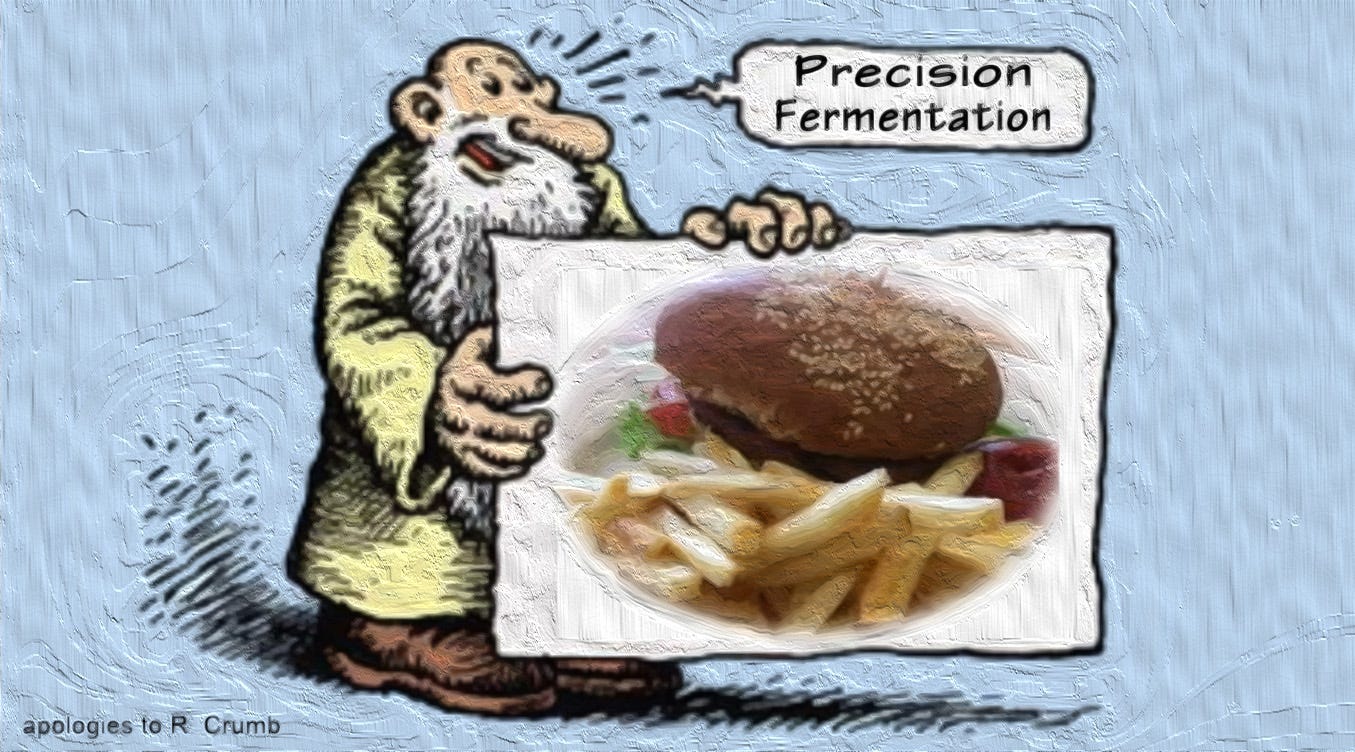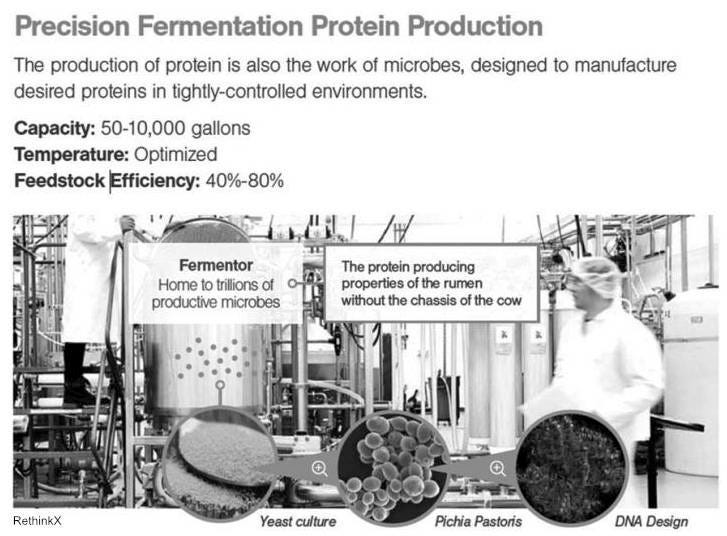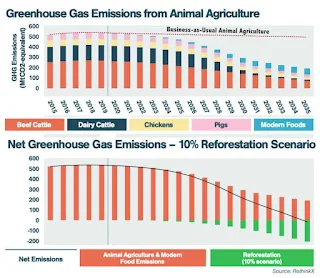The Great Pause Week 78: Rewilding Iowa
"Major producers of animal products are at risk of a serious economic shock."
A few years ago I was at a conference and had a chance to try a fake burger. Vegetarian or vegan since 1970, I had not forgotten the taste of a nicely grilled hamburger and was pleasantly surprised at how good this fake one was. I have to say it was better than most of the bean, gluten and tofu burgers we make at The Farm.
I still wasn’t all that keen on the concept of lab food for the masses, though. I know, and teach, the epigenetic importance of the soil-food-web to the human gut biome, as well all the many dangers of genetically modified (GM) foods. Jeremy Rifkin got that right in Algeny: A New Word, A New World in 1984.
But now I am forced to re-examine some of my thinking in light of the new wave of “precision fermentation” and cell cultures. The guys in lab coats are absolutely correct when they say you don’t need a cow to make milk. We’ve been doing it with soybeans at The Farm since 1971. You can also do it with tree sap, nuts and hemp hearts.
So, while I agree switching to mechanical cows may not be much different than switching from horses to bicycles, I have to fall back on the indigenous shamanic teachings and ask my allies in the plant world if this is really what they want and need.
In The Biochar Solution, I described how ruminants and grasses co-evolved:
When a grazing animal browses ground cover, it removes photosynthetic surface area, so the plant sheds root mass, which becomes labile carbon in the soil. As the animal browses, it is also exhales carbon dioxide, which wafts over the plant and is taken in through pores to build biomass. When the animal excretes, some carbon is lost into the atmosphere as carbon dioxide and methane, but considerably more makes it into the soil, along with nitrogen, phosphorus, and, of course, the rich microfauna contained in the animal’s intestine.
In tropical environments that alternate between seasonally humid and arid, or in temperate zones that alternate between hot and cold, billions of tons of vegetation die each year. The microorganism population needed to decompose the vegetation would also die off from the changed seasonal conditions, were it not for the guts of large grazing animals, which remain a moist and fertile home for microorganisms. Over millions of years, a symbiotic relationship between plants, large animals, and microorganisms has evolved. Even in the harshest part of the year, microbes are able to break down the tough plant material, nourish the grazing animal, and sustain the life of the soil.
Over those millions of years, many species of large herbivores have come and gone, and have usually managed to keep up with the billions of tons of vegetation dying every year. Besides the microfauna in their intestines, the herbivores provide a reseeding service — hooves dig up the soil, digestion stratifies the seed, excrement buries it, rooting mulches, and urine fertilizes — all to ensure the spread and survival of the forage species. Grazing animals garden.
The dung of grass-eating mammals is home to a fascinating zygomycete fungus known as Pilobolus, which feeds on nutrients that have passed through the animal. Eventually it sends up tubes, each tipped with a fluid-filled bulb. On top of the bulb is a black spore packet. The fluid-filled bulbs act as water cannons, propelling the spore packets up to six feet away from the dung.
Pilobolus spores need to be eaten by an animal, which passes them through its digestive system, then excretes them with its dung, providing food for the fungus to continue. If the spores didn’t get propelled away from the dung that Pilobolus lives in, they would never make it back to the animal, because most grazing animals will not graze on or near their own dung.
This dispersal strategy also serves other organisms, in particular, parasitic nematode worms that live in the gut of a grazing animal and send their eggs out with the dung. When the baby nematodes hatch, they climb up the Pilobolus tubes to the spore packet where they, too, are shot out of the cannon like a microbial amusement ride.
Even if fake meat or dairy may taste good and have calories, it is likely to be less helpful for your microbiome or to the grassland ecology. But then, designer meat can include probiotic cocktails and animal protein is presently eating up continent-sized chunks of rainforest at a rate that will finish them off by the middle of the century, so which is worse? Vitamins produced using Precision Fermentation (PF) already include vitamin C, B2, B12, D2, EFAs, K2, coenzyme Q10, pyrroloquinoline quinine (PQQ) and glutathione (GSH). Others can be produced using a combination of chemistry and PF, such as niacin or B3, B5, C, and L-carnitine.
Plant-based substitutes for beef have been doing very well in the marketplace. Beyond Meat debuted on NASDAQ in May 2019 and has reached a market capitalization of more than $7 billion. Tyson foods watch out. They are coming for you.
A couple short weeks after getting regulatory approval to sell cultured meat in Singapore, Eat Just announced last night it has made the first commercial sale of its GOOD Meat Cultured Chicken.— The Spoon, December 2019
You can find Beyond Meat chicken in KFC and its patties in Burger King. Burger King markets the Impossible Whopper by touting its health benefits (0 mg of cholesterol). Israel’s SuperMeat is opening its own test-kitchen-meets-restaurant initiative in Tel Aviv. Soy-based Miracle Meat from Yokohama chain Freshness Burger has attracted more than $27 million in funding this year to scale to 4000 tons production. They may be 10x that in 3 years.
 |
| 3D-printed steak from MeaTech |
Current estimates are that the global market will grow to $88.6 billion by 2030. Finland-based Solar Foods has received 23 million euro to go into production in 2023 with its soy-based alternatives. It reckons the switch to plant protein will actually reduce the amount of soy being grown in the world because most of it goes to animal feed at a 30:1 loss in protein to waste — manure, hair, hide, bone. To feed the estimated 9.8 billion people on the planet in 2050 at present animal-based dietary standards, we would need to farm (mainly by clearing forest) an additional area the size of two Indias — 2.29 million square miles.
Meanwhile, food-processing wastes upcycled by Spanish startup MOA Foodtech — sugar, wheat, corn, beer, potato and fruit — are being fermented into high-value protein ingredients for snacks, pet food and specialized products for athletes, the elderly, diabetics and others. No genetic engineering required; these are just your specialized digestive microbes and thoughtful formulations. No new land required, either.
Since the 1970s, costs of PF food have fallen 10,000,000 times since the first molecules were produced, to about $100/kg today. An order of magnitude reduction, expected to occur between 2023 and 2025, to about $10/kg will unlock the mass market. By 2035, PF protein will be $1/kg while the cost of cow-produced milk protein will have doubled to more than $10/kg. Similar trends will emerge for PF ground beef, reaching cost parity in 2025 and likely three times lower than the cost of conventional meat by 2030.There may be examples of vertical farming that are good but most of what I have seen is just motivated by money.— Food Critic Mark Bittman
Of course, there is something akin to the taxpayer fossil subsidy in the US dairy industry, too, supported by wealthy lobbying. Subsidies add $0.27/kg to milk producers’ net and tariffs protect them from international price pressure.
Nonetheless, most U.S. dairy farmers operate at a loss. In 2018, the lowest quartile of New England dairy farms made a loss of $447 per cow, with the average across all farms a loss of $40 per cow.
As U.S. milk consumption has steadily declined, the guaranteed buyer of last resort has been purchasing surplus production and storing it as processed cheese, periodically releasing as government food assistance or sweetheart deals with fast food chains. In early 2018, USDA partnered with Pizza Hut to include 25 percent more cheese on pan pizzas in an effort to release 70 million extra kilograms of milk per year to the market. Still the pre-pandemic surplus of cheese was the largest ever — 617,000 metric tons.
New to the Lover’s lineup, the Ultimate Cheese Lover’s pizza packs an extra cheesey punch. This new recipe is a mouth-watering combination of Alfredo sauce and three cheeses — Romano, Parmesan, and Pizza Hut’s signature pizza cheese– blended to create an ultimate cheese experience like no other.
— Pizza Hut Advertisement
As the psychology of stranded investment strikes a fossilized food industry seemingly secure by virtue of its successful regulatory capture, it looks like a deer in the headlights' glare. According to a study by RethinkX:
Decision-makers must also recognize there are no geographical barriers to the food and agriculture disruption, so if the US resists or fails to support the modern food industry, other countries such as China will capture the health, wealth, and jobs that accrue to those leading the way.
 Because fake meat uses 98 percent less water and 99 percent less land, it means that by 2035, about 60 percent of the land currently being used for livestock and feed production will be freed for other uses as the cost/price curves cross. According to RethinkX, this liberated territory should be viewed as potential rewilding area. Just in the United States it is about the size of the 1803 Louisiana Purchase — or six Iowas.
Because fake meat uses 98 percent less water and 99 percent less land, it means that by 2035, about 60 percent of the land currently being used for livestock and feed production will be freed for other uses as the cost/price curves cross. According to RethinkX, this liberated territory should be viewed as potential rewilding area. Just in the United States it is about the size of the 1803 Louisiana Purchase — or six Iowas.
RethinkX predicts U.S. greenhouse gas emissions from cattle will drop by 60 percent by 2030 and 80 percent by 2035. Even when the full Life Cycle Analysis of modern food production is included, net emissions from the food sector as a whole will decline by 45 percent by 2030, 65 percent by 2035.
- Water consumption in cattle production and associated feed cropland irrigation will fall by 50 percent by 2030, 75 percent by 2035.
- If all the freed land were dedicated to optimized reforestation and soil regeneration, all U.S. greenhouse pollution — 5.5 billion tons of CO2e each year — could be fully offset by natural drawdown by 2035.
- The cost of modern foods and other precision fermentation products will be at least 50 percent and as much as 80 percent lower than the animal products they replace.
- At current prices, revenues of the U.S. beef and dairy industry and their suppliers will decline by at least 50 percent by 2030, and by nearly 90 percent by 2035. All other livestock and commercial fisheries will follow a similar trajectory.
- Farmland values will collapse by 40 percent-80 percent.
- Major producers of animal products are at risk of a serious economic shock.
- The average U.S. family will save more than $1,200 a year in food costs. This will keep an additional $100 billion per year in USAnian pockets by 2030.
- By 2030, at least half of the demand for oil from the U.S. agriculture industry — currently about 150 million barrels of oil equivalent a year — will disappear.
Extrapolated to the entire world, the rewilding of cattle and cropland and the tree uptake of carbon dioxide would begin to stabilize the atmosphere, gradually withdrawing tens of gigatons of CO2e per year until by mid-century or shortly thereafter, the legacy fossil pollution of earlier centuries would be completely erased. Ice cover would return to Greenland and Antarctica. Ice would once more protect the northern whale migrations. The polar vortex would behave. Storms would lessen in ferocity. Zoonotic viruses would remain in wilderness host populations. Wildfires would diminish. Coasts would be spared monster hurricanes (although sea level will continue to rise for several more centuries).
Externalities not captured in the economic models include the past public health costs of animal protein and dairy, the impact of antibiotic resistance, animal Pharma’s effects on the marine environment, and the ubiquity of high-fructose corn syrup. While public health costs like these were used to justify taxes on tobacco or gasoline, animal foods were exempted and subsidized.
I think I can forego some of my concerns for Pilobolus fungi. They are not in danger of extinction like we are. Still, I have reservations about energy-intensive, technology-intensive foods making up a cornerstone of my diet even if they reduce my intake of HFCS. Even RethinkX admits “potential health issues could arise when incorporating novel food components into the food chain.” I worry about the lack of love in preparing food, as important an ingredient in my health as any I can think of.
At The Farm we went in big for soy in all its miraculous and historical forms, prepared with love every step of the way: milk, tofu, okara, tempeh, grits, butters, miso, shoyu, natto, burgers, dogs, nuts, coffee, flour pastries, granolas, pizza, soysages, yogurt, frogurt, ice bean, frijoles, stroganoff, sufu, yuba, scramble and I am probably still forgetting half the rest. There were and are folks whose digestion can not handle soy but there were also wheat gluten, hemp hearts and many other plant bases from which entire cuisines can be constructed, naturally.
All told, this is great news. 2025 is not very long to wait for the brick to drop on concentrated animal feeding operations (CAFOs) and their 370 million tons of manure leaking from overflowing lagoons, battery cages for hens, gestation crates for sows, tail-docked caged cattle, tormented veal calves, and other forms of unspeakably inventive torture. The sooner that industry is disrupted, the better.
At that point, we may learn whether Townsend or Bowen is the more correct. Given virtually unlimited, high-quality food and abundant land and water, will population once more burgeon, or, having adequate opportunity now for provision of the four prerequisites of population decline, will it drop?
__________________________
The COVID-19 pandemic has destroyed lives, livelihoods, and economies. But it has not slowed down climate change, which presents an existential threat to all life, humans included. The warnings could not be stronger: temperatures and fires are breaking records, greenhouse gas levels keep climbing, sea level is rising, and natural disasters are upsizing.
As the world confronts the pandemic and emerges into recovery, there is growing recognition that the recovery must be a pathway to a new carbon economy, one that goes beyond zero emissions and runs the industrial carbon cycle backwards — taking CO2 from the atmosphere and ocean, turning it into coal and oil, and burying it in the ground. The triple bottom line of this new economy is antifragility, regeneration, and resilience.
Help me get my blog posted every week. All Patreon donations and Blogger subscriptions are needed and welcomed. You are how we make this happen. Your contributions are being made to Global Village Institute, a tax-deductible 501(c)(3) charity. PowerUp! donors on Patreon get an autographed book off each first press run. Please help if you can.
#RestorationGeneration
“There are the good tipping points, the tipping points in public consciousness when it comes to addressing this crisis, and I think we are very close to that.”
— Climate Scientist Michael Mann, January 13, 2021.
Want to help make a difference while you shop in the Amazon app, at no extra cost to you? Simply follow the instructions below to select “Global Village Institute” as your charity and activate AmazonSmile in the app. They’ll donate a portion of your eligible purchases to us.
How it works:
1. Open the Amazon app on your phone
2. Select the main menu (=) & tap on “AmazonSmile” within Programs & Features
3. Select “Global Village Institute” as your charity
4. Follow the on-screen instructions to activate AmazonSmile in the mobile app








Comments
The same way solar and wind power will be added to existing hydrocarbon electrical generation, rather than replacing it. This is to power more cars. Also the same way greater numbers of expensive gasoline and diesel trucks and SUVs will be sold to internally subsidize EVs.
Human populations can decline but what matters is relentless increase in the numbers of cars; the manufacture and sale more and more cars and all the worthless crap that goes along with them.
Tycoons' claims on waste comes first, last and always.
This is a most intriguing bit of research you've pulled together this week, Albert. Fermented novel foods could be the salvation of us all, you seem to imply, just reserving the possibility that Jeavons will arise and we'll keep on breeding.
Just in the nick of time for residents of California if this WP article is right about water storage in Lake Mead. “Lakes Powell and Mead may never recover… Depleted by drought, Lakes Powell and Mead were doomed from the beginning.
“A glimpse into the history of the Colorado River Basin system, how it was designed and the impacts of climate change shed light on why it was destined to fail.”
https://www.washingtonpost.com/weather/2021/09/10/lake-powell-mead-drought-history/
And PF certainly requires the background infrastructure of a very high tech industrial civilization, so even if it reduces land area required for food production, it still needs all the rest of industrial civilization, including the mining, manufacturing, and energy extraction sectors, etc.
I delved into the Lake Mead/Lake Powell situation in my Patreon post a few weeks ago. It is not just Las Vegas at risk. When they decommissioned San Onofre nuclear plant they did not have approval to remove spent fuel to anywhere so they designed and built a parking lot of dry casks to replace the swimming pools. The casks are actively cooled by water from Lake Powell. Lose that for 10 minutes and they overheat and you may even get criticality if they crack or melt. They are not designed to move as casks because no truck or train could supply the continuous water coolant required. We shall see what ingenious Rube Goldberg fix they come up with next. It won't be cheap.
I think you are mistaken about the cooling of dry casks. They are passively cooled by air convection, not water. Dry cask storage is much safer than cooling pools, though the casks will probably not last as long as the contents are radioactive. Still, dry cask storage is much safer than cooling pools. Spent fuel should be put in dry casks as soon as possible, but they are expensive so power companies have persuaded the NRC is letting companies keep far too much spent fuel in the pools. That permission, plus the lack of long term geologic storage is bordering on criminal, in my opinion.
Lab-grown "meat" is none of these, unless some genius works up a way for folks to to it at home, or at least on a neighborhood scale. As I understand it (and, I think, as you do) we need to take the path of technological descent if we are to survive. I think the "survival diet" of the future is based around grains and beans, not lab meat.
Perhaps the only "lab meat" in our post-collapse future is when the scientists start raising white rats to eat them. :-)